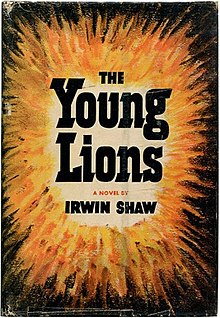The Young Lions

First edition
|
|
| Author | Irwin Shaw |
|---|---|
| Country | United States |
| Language | English |
| Publisher | Random House |
|
Publication date
|
1948 |
| Media type | Print (hardback) |
| Pages | 689 |
| OCLC | 275267 |
The Young Lions (1948) is a novel by Irwin Shaw about three soldiers in World War II.
Christian Diestl is at first a sympathetic Austrian drawn to Nazism by despair for his future but willing to sacrifice Jews if necessary; Noah Ackerman is an American Jew facing discrimination of the American kind; and Michael Whitacre is an American WASP who struggles with his lack of meaning arising from his lack of struggles.
The three have very different wars: Diestl becomes less sympathetic as he willingly sacrifices more and more merely to survive; Ackerman finally overcomes the discrimination of his fellows in the army only to be nearly undone by the horror of the camps; Whitacre, still without meaning in his life, survives them both.
In a 1953 interview, Shaw commented, "what I was trying to do in The Young Lions was to show the world at a certain point in its history, its good and evil, and as many people as I could crowd into the book struggling through that world, trying to find some reason for trying to stay alive in it". He described the character of the German soldier Christian: "I wanted to show how a man can start out decent, intelligent, well meaning, as so many people in Germany must have been, even in the greatest days of Nazism – and wind up bestialized, almost bereft of humanity, almost dead to the instincts of survival even, as the Germans finally were, by believing in one false thing, which spreads and spreads and finally corrupts them entirely".
Shaw said that, in addition to the three central figures of the novel, he had originally intended to include a fourth, non-human character – a bullet which would act as a link between the other three characters. The novel would follow its origin from when the lead is mined from the ground, through to its manufacture and its journey to ending up in Whitacre's cartridge belt and finally used to kill Diestl in the novel's climax. But Shaw gave up the idea as "unnecessary and grandiose".
Kirkus Reviews praised the novel in 1948, saying "If not directed at a popular level, this is the outstanding novel to have come out of the war, in the universality of its framework, its thoughtfulness, and its writing which is swift, believable and often brilliant".
Jonathan Yardley, writing in 2009 in The Washington Post, identified The Young Lions as one of the four epic American war novels that emerged in the immediate post-war era. The other three were The Naked and the Dead by Norman Mailer (1948), The Caine Mutiny by Herman Wouk (1951) and From Here to Eternity by James Jones (1951). He wrote, "Today, at a remove of well over half a century, it is difficult to conjure the incredible excitement these books created, not merely the sense that the terrible war had inspired fiction of lasting importance but also the belief that the 'Great American Novel' at last was within reach". Yardley wrote that some of Shaw's short stories are minor classics and that portions of The Young Lions approached this level but as a whole, "it is too prolix and flabby to fulfill the high ambitions Shaw obviously had for it". Yardley believes that, like the other three novels mentioned above, Shaw's novel has more value as a document of war than as a literary accomplishment.
...
Wikipedia
